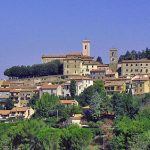The ruins of the high tower Donoratico dominate a large stretch of the Tyrrhenian coast. Surrounded by the scant remains of the two walls which enveloped her, from the foundations of the ancient church and other buildings castrense recently come to light [last archaeological excavations are still in what remains of the ancient castle built by the Counts of Donoratico, Della gherardesca. Since the mid-1100 became their privileged seat. The function of the castle was to defend this part of the coast from the bloody incursions of the Saracens, pirates and enemies of the Republic of Pisa before and during the 1400’s, then Fiorentina.
The discovery of pottery and a defensive circuit ‘Cyclopean’ [that is built with large blocks of stone], in addition to the presence of the same period tombs carved into the rock of the terraces underlying test the presence of this hill fortress of an important and extensive Etruscan . The first explicit mention of a fortified settlement dating back to 1176, but the existence of the castle is certainly older and it seems, thanks to the dating of artifacts found during excavations belonging to a settlement prior to the wooden castle of stone, dates back even before the X century.
The first city walls of stone that runs along the edge of the summit of the hill, of which there are many stretches south-west and south-east, from the second half of the eleventh century. The stone was used inside the enclosure for the construction of the church, provided with a single nave and expanded in the next century. During the twelfth century it was first built as a fortified tower used by the Gherardesca, with wooden floors and a vaulted brick, near the church along with new walls, taller and thicker, which are still some sections intact – on the slopes west and east – and the original front door to the north. The summit area was enclosed in a second ring fortified with a single entrance open down the stretch southwest. Even the church was enlarged and embellished. In the following century was built a new tower leaning against the existing one. Between the fourteenth and fifteenth century were carried out actions aimed at strengthening the existing structures, building in some parts of the scarp walls leaning against the wall circuit, but also began the abandonment of the first houses. The core of the castle was blown up in 1447 by the army of King Alfonso of Aragon during his descent in Maremma.
Even today, the main tower rises for all its primitive height with fully intact perimeter side and part of the south east and west. On the east side of this tower is another structure whose sides and openings are still legible. The two buildings are one of the most important examples of medieval architecture in this area and formed the residence. Of the village, distributed concentrically along the terraces below, are identifiable in the vegetation and in spite of the massive collapse, remains belonging to buildings that constituted it. During the recent excavations have brought to light terracotta floors and stone, the outer walls of the church and some of its square columns aisle.
The first explicit mention of a “castrum” dates back to 1176, but the memory of “domains of Donoratico” already in 1161 is assumed that the existence of the castle is the oldest.
The church castrense is documented in the twelfth century, while that of S. Columba, attested since the eleventh century among the possessions of St. Peter Monteverdi, was located, as shown by an act of 1263, “iusta castrum in plano ipsius castrate.”
Some acts of the second half of the twelfth century testify to the presence of rights in the stately castle among different subjects: a branch of the Counts Gherardeschi and the monastery of St. Peter in Palazzuolo
From the second half of the twelfth century the settlement became the seat of the most important branch of privileged accounts Gherardeschi, which later took the name from the castle. In 1270 the castle was occupied by Donoratico accounts Biserno, rebels to the municipality of Pisa and supported by the forces of Guelph and Angevin. In this period, next to the summit area there was a “burgus”, index of a certain consistency demic settlement. During the fifteenth century, as the neighboring towns and the castle Donoratico passes under the dominion of Florence in conjunction with the gradual abandonment of areas neighboring settlement
In the summit rises for all its primitive height of a tower which preserves completely the perimeter side and part of the south east and west. Immediately adjacent to the east side of this tower is another turreted structure whose sides and their openings are still legible. The two buildings, dating from the twelfth and fourteenth century and which represent one of the most important examples of medieval architecture in this area, were part of the settlement of the manor.
Based on a structure that is repeated in all the castles of this area the settlement was in fact made up of a summit area, where there were the stately buildings and a village below, the underlying distributed concentrically along the terraces and defended by a walls in stone. In its turn, the area was surrounded by elegant another defensive circuit, as in the case of this castle, right near where the towers described above are clearly visible remains of the walls and the door that led into the area high.
Traces instead of the defensive circuit of the village are recognizable on the slopes west, east and north where it still retains one of the main gates to the castle.
Among the vegetation, despite the massive crashes, it also recognizes the trend of many walls belonging to probable buildings that made up the village.
During the excavations 2000 and 2001, in the summit area were opened four areas (1000 – 2000 – 4000 to 5000) within the original area and the elegant terraces to the west of the latter.
At the same time, work has begun excavation of two large areas (3000 – 7000) located at the back portion of the south-west and south-east internal wall circuit at the space originally occupied by the village.
These activities followed by the cleaning of the undergrowth at the area south-east of the village aims to bring to light the evidence walls are not covered with soil deposits, later placed in the general relief of the settlement.
The deposit excavated so far revealed a complex stratigraphic sequence on a chronological period between IV-III century BC and fifteenth centuries.
Quick guide for the search of its solutions for holidays in Donoratico.
Those who approach the idea of spending his holidays in Donoratico will need to consult a guide to find hotels Donoratico Donoratico hotels or hotels Donoratico.
The Italianists prefer to look for hotels or hotels on the Tuscan coast in Tuscany.
It should however consider that Donoratico is located on the Etruscan Coast, which is in fact in Tuscany sea, and the Coast Tuscany is unique in the world.
Then refer to the Help in the Tuscan coast hotels will be well oriented to the voice holidays Tuscan coast and search for hotels in the fen or, if you prefer, hotels Tuscany Coast.
Given that in recent years tourism has largely shown a preference for solutions besides housing type hotel, residences Donoratico Donoratico apartments, holiday apartments in the Tuscan coastline, have become frequent rumors of research on texts related tourism guide the Tuscan coast.
It is also for this second chapter as previously said about the Etruscan Coast, then in reading pamphlets about Donoratico or even where to sleep only to be sought in Tuscany or type the entries residence Donoratico Donoratico apartments, hotels or hotels Donoratico Donoratico.
The search for residence on the Tuscan Coast could be profitable since the topic is more general summer holiday in Tuscany, apartments for rent, seaside tuscany, holidays on the sea.
For those who opted for a specific area such as the Etruscan Coast or Donoratico in a particular way, it will be well to remember that the search terms to be extended to Donoratico studios besides vacation rental Tuscany Tuscany or even sea or farm Donoratico.
Then there is the chapter of the holiday apartment very popular among couples and even by couples with a baby. Studios for rent Tuscany is therefore a search term very profitable, as well as studio apartments or houses Tuscany Donoratico.
For those in search of the substance and a room can be enough rooms or rooms holiday accommodation Tuscany Coast Tuscany or even rooms for rent Tuscany should be appropriate search terms as well as rooms Donoratico.
Finally, not least, we must remember ‘s Farm or Tuscany Farmhouses Tuscany.
So let’s look at farm Donoratico.
It is not to be neglected even the search for rooms Donoratico, after all we are talking about Tuscany Italy, holiday apartment Tuscany, someone with more economic means looking Donoratico villa or villa for holiday Donoratico Tuscan coast.


